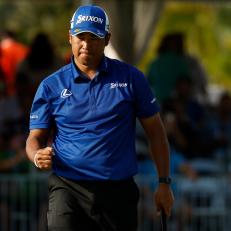Swing Sequence: Russell Henley
Golf instructors hate wasted motion. They don't want to see overly active legs or too much hand or wrist action. The simpler and more efficient the golf swing is, the better the chances it will produce consistency. That's why swing coach Bobby Hix loves these photographs of his student Russell Henley, who won the Honda Classic in March in a four-man playoff that included Rory McIlroy. Henley and Hix have been working together since Henley was 12.Hix says the improvements they've made recently are noticeable and that Henley's swing is now more streamlined. "You can save shots mid-swing if you're athletic," Hix says, "but you can also harness that athleticism to improve your technique. That's what Russell's doing."By relying on a fade, Henley has become one of the better drivers on the PGA Tour, ranking 22nd in total driving, a measure of distance and accuracy."It's more of a body swing," Henley says. "I feel like I'm turning through with my body, and my hands aren't rolling over when I hit the ball. I have a much better chance of keeping my driver in play this way." —Ron Kaspriske
CREATING A BIGGER BASE"Russell had a narrow stance growing up," says Henley's longtime instructor, Bobby Hix. "That caused a lot of leg action. Now his stance is wider, which quiets the legs. And his grip is weaker [hands not turned away from the target] to promote a fade."
REDUCING WRIST ACTION"Compared to a few years ago, he doesn't cock his wrists until much later in the backswing," Hix says. "He's moving his arms and body together to simplify his swing and to make it easier to reconnect everything on the way back down."
ELIMINATING THE HOOK"Russ used to let his arms keep going after his shoulders stopped turning," Hix says. "Sometimes the club would fall behind him coming down, then he'd over-rotate the face at impact and hook it. Now his swing is shorter, so the club stays in front of him."
PREPARING FOR THE HIT"When his hands are halfway down, a good part of his back is still facing the target," Hix says. "Not only does this give him a little more swing speed when he finally does turn through, it also keeps the club on the proper plane coming down."
SYNCING UP AT IMPACT"Being 'on top of the ball' means you haven't unwound your upper body too early," Hix says. "Russell does this very well. His chest, hands and club arrive at impact at the same time. That makes it really easy to control the clubface."
STAYING ON YOUR FEET
"Look at his left foot at the finish: It really hasn't moved at all," Hix says."That proves he doesn't have that extra leg action anymore. He's rotating his body over a stable left leg. That's the turn he talks about—and it's how he fades it."
















